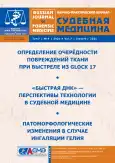Features of the ejection and topography of the distribution of metal particles of a destroyed projectile after overcoming an obstacle made of triplex glass of a car
- Authors: Leonov S.V.1,2, Pinchuk P.V.1,3, Suhareva M.A.2, Shakiryanova J.P.1,2, Shishkin Y.Y.4,5
-
Affiliations:
- Chief State Center for Forensic Medicine and Forensic Expertise 111
- Moscow State University of Medicine and Dentistry named after A.I. Evdokimov
- The Russian National Research Medical University named after N.I. Pirogov
- Ivanovo Regional Bureau of Forensic Medical Expertise
- Ivanovo State Medical Academy
- Issue: Vol 7, No 4 (2021)
- Pages: 13-18
- Section: Original study articles
- URL: https://journals.rcsi.science/2411-8729/article/view/122403
- DOI: https://doi.org/10.17816/fm386
- ID: 122403
Cite item
Full Text
Abstract
BACKGROUND: The article describes experimental studies aimed at studying the features of post-retrograde gunshot trauma using the latest modern methods of forensic medical research.
AIMS: The aim of the work was to study the nature of the distribution of metal particles of a destroyed firearm projectile after passing through an obstacle ― triplex glass.
MATERIAL AND METHODS: As a barrier, car windshield triplex windows are used, located at an angle of 60° to the aiming line. The shots were fired from the Saiga-MK carbine with 5.45×39 BPZ FMJ cartridges. During the experiments, shots were fired from a distance of 10 m (a total of 30 shots were fired). White cotton fabric (calico) with dimensions of 100×150 cm, fixed on a chipboard, was used as targets. The distance between the target and the barrier was 100 cm. The targets were studied using a scanning electron microscope Hitachi FlexSem 1000 II and an energy-dispersive X-ray spectrometer Bruker Quantax 80. In the course of the experiment, high-speed video shooting was carried out with a Sony RX0 video camera with a frequency of 1000 fps.
RESULTS: A frame-by-frame study of the obtained video recordings showed that the deviation of the flight of the projectile fragments from the original trajectory was up to 10º side of the normal to the back surface of the glass. The fragments of the projectile, having overcome the barrier, moved in stages, in 3 phases: overcoming the barrier, ejecting fragments in the form of a cone, breaking through the target and retrograde movement of the fragments of the barrier. The scanning electron microscope and energy dispersive spectroscopy studies showed that the topography and morphology of the distribution of metals on the target surface correspond to the data of the analysis of the movement of parts of a firearm during high-speed video shooting. The metal alloy found on the target contained the following elements: plumbum (Pb), cuprum (Cu), antimony (Sb), and kalium (K).
CONCLUSION: When conducting an experimental study, it was found that various types of particles that were destroyed during the passage of the barrier, a firearm projectile, are registered on the surface of the target. The nature of the particle distribution and their morphology are very specific, and most likely a qualitative assessment of the projectile particles on the target will allow us to determine the distance of the shot beyond the barrier.
Full Text
##article.viewOnOriginalSite##About the authors
Sergey V. Leonov
Chief State Center for Forensic Medicine and Forensic Expertise 111; Moscow State University of Medicine and Dentistry named after A.I. Evdokimov
Email: sleonoff@inbox.ru
ORCID iD: 0000-0003-4228-8973
SPIN-code: 2326-2920
MD, Dr. Sci. (Med.), Professor
Russian Federation, 3, Hospital square, Moscow, 105094; MoscowPavel V. Pinchuk
Chief State Center for Forensic Medicine and Forensic Expertise 111; The Russian National Research Medical University named after N.I. Pirogov
Email: pinchuk1967@mail.ru
ORCID iD: 0000-0002-0223-2433
SPIN-code: 7357-3038
MD, Dr. Sci. (Med.), Associate Professor
Russian Federation, 3, Hospital square, Moscow, 105094; MoscowMarina A. Suhareva
Moscow State University of Medicine and Dentistry named after A.I. Evdokimov
Email: suha@yandex.ru
ORCID iD: 0000-0003-3422-6043
SPIN-code: 4692-0197
MD, Cand. Sci. (Med.)
Russian Federation, 3, Hospital square, Moscow, 105094Juliya P. Shakiryanova
Chief State Center for Forensic Medicine and Forensic Expertise 111; Moscow State University of Medicine and Dentistry named after A.I. Evdokimov
Email: tristeza_ul@mail.ru
ORCID iD: 0000-0002-1099-5561
SPIN-code: 1429-6230
MD, Cand. Sci. (Med.)
Russian Federation, 3, Hospital square, Moscow, 105094; MoscowYuri Yu. Shishkin
Ivanovo Regional Bureau of Forensic Medical Expertise; Ivanovo State Medical Academy
Author for correspondence.
Email: shishkinuu@rambler.ru
ORCID iD: 0000-0002-1029-9056
SPIN-code: 6170-1340
MD, Dr. Sci. (Med.)
Russian Federation, Ivanovo; IvanovoReferences
- Eidlin LM. Gunshot injuries: medical recognition and forensic assessment. Voronezh: Voronezh Regional Publishing House; 1939. 223 p. (In Russ).
- Eidlin LM. Gunshot injuries. 2nd ed., revised and updated. Tashkent: Medgiz; 1963. 331 p. (In Russ).
- Bedrin LM. On the features of damage in ordinary and some peculiar rifle bullet injuries: 14.00.24 [dissertation abstract]. Voronezh; 1951. 21 p. (In Russ).
- Ogarkov IF. Influence of some types of clothing and shoes on the picture of the entrance and exit holes when firing a rifle from close distances. In: Questions of forensic medical examination. Ed. by M.I. Avdeev. Moscow; 1954. Р. 40–45. (In Russ).
- Kalmykov KN. Forensic medical characteristics of the defeat by ordinary and special bullets of the 1943 sample, which previously overcame the obstacle: 14.00.24 [dissertation abstract]. Leningrad; 1961. 23 р. (In Russ).
- Molchanov VI. Some questions of forensic medical examination of gunshot injuries: 14.00.24 [dissertation]. Leningrad; 1964. 683 р. (In Russ).
- Kustanovich SD. Investigation of clothing damage in forensic medical practice. Moscow: Meditsina; 1965. 220 p. (In Russ).
- Popov VL, Shigeev VB, Kuznetsov LE. Forensic ballistics. Saint-Petersburg: Gippokrat; 2002. 431 p. (In Russ).
- Zukas JA, Nicholas T, Swift HF, et al. Impact dynamics. Moscow: Mir; 1985. 296 р. (In Russ).
Supplementary files









